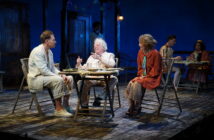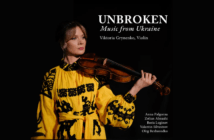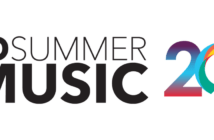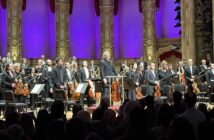
This page is also available in / Cette page est également disponible en:
![]() Francais (French)
Francais (French)
The ghost light standing vigil on the Metropolitan Opera’s silent stage has never burned this constantly or for so long. Even during the flu pandemic of 1918, the Met – like virtually every other theater in New York City – carried on.
There has been death on the Met stage (the performance continued), suicide in the audience (which halted things that day), even a bizarre sprinkling of cremated human remains into the orchestra pit (causing cancelation of half a matinée plus that evening’s performance). But, by and large, the Met’s seasons have unfolded in regular and stately grandeur every year since 1883.
Then came 2020
Ned Hanlon – a member of the Met’s chorus and chair of its labour negotiating committee – recalls being in rehearsal on March 12 last year when the announcement came: Given COVID-19’s growing threat, all Met operations were shutting down. All personnel were to leave the building immediately. That night’s performance of La Cenerentola was the first to be spiked. Hundreds of performances of nearly two dozen other operas followed suit.
Naturally, no one at the time knew how long the silence would last. Certainly, none anticipated a pause of 13 months and counting.
But the real surprise came when the pandemic became a predicate for the upending of union contracts. Amidst austerity, the Met insisted on a back-to-square-one appraisal of its relationships with all its unionized workers.
The major unions all had contracts in effect at the time, “but our force majeure clause specifically mentioned pandemics,” Hanlon says of the Met’s contract with AGMA (the American Guild of Musical Artists, which represents the chorus, dancers and several other groups). The same held true for contracts with Local 802 (representing members of the Met orchestra) and Local One (the IATSE-affiliated union of stagehands and backstage technicians). And, while employer contributions for performers’ and musicians’ health benefits have continued, all union wages were withheld beginning April 1, 2020.
Met general manager Peter Gelb offered a partial restoration of pay if the unions accepted an immediate and long-term renegotiation of contracts. His proposal called for an upfront 30% cut in wages (though the stagehands’ union says that the Met’s attorneys recently emailed them a recalculation alleging that, when all the fine print is factored in, the cuts really amount to only 21%, while the musicians’ union claims that, all told, the cuts come closer to 40%), a five-year freeze at the new reduced level, and an eventual increase back up to 85% of original rates at a date uncertain, when box office receipts return to pre-pandemic numbers.
None of the unions accepted
“Destructive and draconian” is how Local 802 musicians’ union president Adam Krauthamer characterizes the proposed cuts. “It would take virtually 25 years for the orchestra to return to pre-COVID pay.”
The Big Three
Local One’s contract was up for renegotiation at the end of July 2020 anyway, but those for Local 802 and AGMA remain in force through July 2021. Still, prompted by the prospect of recapturing some income during the shutdown, each union issued counterproposals, as well as suggestions for how the Met could trim costs through improved efficiencies.
Ours was a significant proposal,” says James J. Claffey, Jr., president of the stagehands’ Local One, of his union’s offer, “and was just out of hand rejected.”
“They never responded to the concessionary proposals we gave them,” echoes Krauthamer of Local 802’s offer. “Not once.”
Tensions ratcheted up throughout the fall, culminating in the Met’s now infamous lockout of the by-then contractless stagehands on Dec. 8.
Grievances abound, with sore spots that include Gelb’s outsourcing of set-building to non-union shops in California and the U.K.; Met sponsorship of various 2020 fundraising events (like its glitzy New Year’s Eve recital broadcast from Europe) without the participation of – or compensation to – union members; and the hefty revenue the Met has wrung from pay-per-view exhibitions of past Live in HD Met recordings – again, without union remuneration.
Hear Me Out
But contract wrangling is nothing new at the Met. As recently as 2014, a dispute based on a proposed 10% pay cut generated highly public, union-driven “Save the Met!” jeremiads. Met watchers may thus be tempted to say they’ve seen this production before.
Is the situation direr this time? Arguably yes, but only because it’s a direness nearly universal in scope.
Prior to the pandemic, Met musicians were estimated on average to receive salaries of around US$3,000 per week. Chorus members earned in the same general range.
The Met’s 350 stagehands are said to take in on average more than US$200,000 a year each (some much more), though Local One president Claffey is passionate in narrating the long hours, heavy labour, missed holidays and highly impacted family life (including “countless” divorces) that the job entails.
“We’re not going to apologize for any of the money,” Claffey says. “They earn every single penny.”
Still, as Gelb himself pointed out with chastening bluntness in a taped message about the pandemic this past September, “Look around you and you will see countless businesses going under, and millions of people unemployed, with no relief in sight.”
True. So, do opera employees warrant special insulations from the vicissitudes of natural history?
Past as Prologue
The Met inaugurated its original house in 1883 with a gala production of Gounod’s Faust. Its 1966 transfer to its immense 3,800-seat digs at Lincoln Center was marked with a commensurately grandiose if plaguy production of Barber’s Antony and Cleopatra. The Met is the largest opera-presenting company – and venue – in the world. Thus everything about its operation, solvency and long-range prospects lacks easy comparison.
Might one suggest a sort of Faustian bargain which actuated the Metropolitan Opera at its very inception? Size matters, and the COVID-19 pandemic may be disclosing how enormity links darkly to destiny – the genetic marker of a parlous institutional comorbidity.
The Peter Principle
Gelb is but the latest signatory to the Met’s existential bargain, but a fully deserving legatee. A lifelong Met habitué – he ushered there as a teen – Gelb came to the helm in 2006 following a high-profile commercial-sector career that included founding the tech media wing of the now disbanded Columbia Artists Management.
Variously characterized as an adventurer, a visionary, a gambler and a spendthrift, Gelb has experienced his share of triumphs and failures. Upside items include the Met’s 2019 Porgy and Bess, and its reboot of Philip Glass’s Akhnaten, the same year. Misfires include Adams’ and Goodman’s rancid The Death of Klinghoffer in 2014 – a prioritizing of controversy over quality. There have been lurid revelations of in-house sexual misconduct (Levine, Domingo), but also the glorious technological and artistic innovations of “The Met Live in HD”– a veritable sui generis new artform.
“My philosophy is that art can be both commercially successful and artistically successful,” Gelb once told The New York Times. He has stress-tested that tenet – for better or worse – many times at the Met.
“He wants to make his legacy,” says Claffey. “We give him credit for that. But that doesn’t mean you come to us and say, ‘Sorry, I lost several million dollars. I’m going to have to take it from you.’”
Board Game
But Gelb is no sole proprietor. He appears to enjoy robust support from his board of directors, who recently renewed his contract through 2027, well in advance of its scheduled review. He has declined to take any personal compensation since the beginning of the pandemic; but a potent sentiment lingers among union leadership that he is exploiting the crisis cynically to gain contract concessions he otherwise could not.
“We’re positive about wanting to bargain with the Met,” says Krauthamer, “but we will not participate where they seek to gut our contract.”
Each of the unions has sponsored fundraising and relief initiatives for its members during the furlough period. Further, while influential onlookers such as Chicago Symphony Orchestra music director Riccardo Muti and Vienna Philharmonic chief Daniel Froschauer have issued open letters deploring the Met’s dearth of support for furloughed artists, the Met’s own music director, maestro Yannick Nézet-Séguin, personally pledged up to US$50,000 in matching grants for orchestra and chorus financial relief.
By contrast, however, a curiously generalized parsimony has characterized gestures of in-house philanthropy among the board of directors.
“One or two members of the Met board have been extremely generous,” says Hanlon, adding, however, that the largesse is “not widespread. I don’t want to guess as to why.”
“I know that people on the board are incredibly supportive of the orchestra,” says Krauthamer. “So there’s a disconnect there between that thinking and the proposal Gelb has made.”
Tutti a tavola
Gelb’s most recent gambit has been to offer union workers “bridge pay” of US$1,543 a week (less any amount received through unemployment insurance) for a minimum of eight weeks if leadership at least comes to the bargaining table. It seems to be panning out, at least in part, with a curiously inverse relationship between each union’s institutional memory and its willingness to deal.
AGMA (the youngest of the Big Three, founded in 1936) entered talks first, on Feb. 8. Local 802, with a history rooted earlier in the 20th century, joined just this past St. Patrick’s Day.
Local One, however, with a 19th-century pedigree that makes it nearly coeval with the Met, has yet to dialogue.
“It’s always been the Met’s position,” says Claffey, “that you get one of the ‘Big Three’ to make a deal and the others will follow.” But no negotiating breakthroughs have been reported so far. (AGMA says their talks have revolved more around issues of inclusion and equality than take-home pay.)
Is it the Money?
Still, as galvanizing as discussions of the dollar may be, one senses there’s something deeper at play here. More profound, even poignant – alienated affection. A desire for acknowledgement. A bid for basic respect.
“You develop a sense of camaraderie and family,” says stagehand Aaron White, a nearly-30-year veteran of the Met shop. “And the unfortunate thing with Mr. Gelb is that he’s rending that fabric. His attitude towards his workers has been dismissive, and we take that to heart.”
Met long-timers express warm nostalgia instead for the personal touch of Joseph Volpe, Gelb’s predecessor as general manager.
“Joe Volpe started out as an apprentice,” says White. “He understood the workings of the building, which we don’t feel is reflected in the way Mr. Gelb runs it.”
“Joe was fair,” says Claffey. “He knew the grind that everybody was put through – and he knew when we were jerking him at the table.”
A Conversation with Joe
Reached for comment, Volpe, who is now executive director of the Sarasota Ballet, avowed no inside knowledge of current negotiations at the Met, but offered that “obviously, for everybody’s sake, I hope there will be some agreements reached. There will be a new normal, but I don’t know what that’ll be at this point.”
Of his own executive approach to the pandemic’s financial upheavals, Volpe explains: “We just extended the existing contract for a year. Through the generosity of our donors, we were able to continue our dancers’ pay at 75% of the contract rate.”
Volpe did speculate on the prospect of government cash infusion at the Met.
“There’s going to be a new grant available the beginning of April,” he says, “which could provide up to US$10 million to shuttered venues, so there’s some hope there also.”
Volpe had no hand in selecting Gelb as his successor in 2005/2006.
“That was entirely done by the board,” he says. “I was not involved at all.”
Interestingly, however, during Gelb’s first round of major union negotiations in 2010, he hired Volpe to return to handle the talks for him.
All Together Now
Peter Gelb fondly quotes his father, former New York Times managing editor Arthur Gelb, as saying, “Criticism from all sides is usually an indication that you’re doing something right.”
Or is it an index of something else? Masked by their apparent opponency, Gelb and the unions may really be more similarly situated than they realize, stakeholders all in the Met’s culture of old-style, Dress Circle grandiosity.
Opera companies that have fared most successfully during the past year have been modest in size and nimble in strategy. While the Met is dark, San Diego Opera mounted La bohème at a drive-in movie theatre; Palm Beach Opera produced The Magic Flute in an outdoor amphitheatre; the Glimmerglass Festival is constructing outdoor parterre boxes for this summer’s performances on its expansive lakeside lawn in Cooperstown, N.Y.
None of this is mere logistical ingenuity. It’s canny congruence to cultural change. “An amazing, creative, entrepreneurial response,” in the words of Marc Scorca, president of Opera America. “Staying in touch with current audiences and discovering new audiences.”
The Met boasts monumentality, historical precedence, impressive real estate and exquisite acoustics. But how do those stack up in a new environment of virtuality, atemporality and a proliferation of algorithm-driven entertainment choices (not to mention the imperatives of “woke culture,” “cancel culture” and gender and racial “equity”)?
“I try to encourage people to be very intentional about how they resume,” says Scorca. “The easiest way is to go back to doing it the way we did it. The harder way is to ask ourselves, ‘What is it we really want to do?’”
On the far side of labour negotiations, come the dawn of mass vaccinations, herd immunity and the re-quickening of the world’s cultural pulse, does the future belong to the Metropolitan Opera? Will cost-cutting and work-rule revisions suffice when the post-pandemic Faustian bargain comes due?
The devil only knows.
This page is also available in / Cette page est également disponible en:
![]() Francais (French)
Francais (French)















